In 1854 Carson took the challenge and felled the first Redwood for a sawmill, and shipped it out on the
schooner “Cydras”. In 1863 Carson entered into partnership with John Dolbeer, who would go on to invent
the “steam donkey”, which would revolutionize logging. Together they would reap the benefits of being the
first and the fastest in the lumber industry. Carson would become a millionaire as co-owner of four mills,
vast timber forests, and a fleet of lumber schooners.
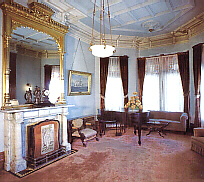 The most spectacular room in the mansion is the front parlor. One of three onyx fireplaces is
found here. The onyx came from Mexico where it was personally purchased by Mr. Carson on one
of his numerous trips to that country. The stone has a delicate, almost translucent shading of
pink and blue. A huge gold framed mirror tops the fireplace, reaching almost to the ceiling.
An alabaster chandelier, similar to several in other rooms, hangs in the center.
On the wall to the right is an original oil painting of the sailing ship "William Carson",
named in honor of the lumberman.
The most spectacular room in the mansion is the front parlor. One of three onyx fireplaces is
found here. The onyx came from Mexico where it was personally purchased by Mr. Carson on one
of his numerous trips to that country. The stone has a delicate, almost translucent shading of
pink and blue. A huge gold framed mirror tops the fireplace, reaching almost to the ceiling.
An alabaster chandelier, similar to several in other rooms, hangs in the center.
On the wall to the right is an original oil painting of the sailing ship "William Carson",
named in honor of the lumberman.
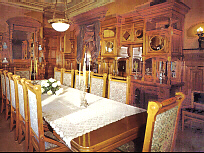 William Carson spared no expense when it came to the production of the house.
Oak predominates in the dining room where the sideboards were built to Mr. Carson's
specifications, copied from a castle in Mexico City. William Carson's sailing ships brought
materials from Mexico, South America and the Philippines, including 97 thousand feet of
hardwood for the interior. Massive chairs that match the table are upholstered with French tapestry.
William Carson spared no expense when it came to the production of the house.
Oak predominates in the dining room where the sideboards were built to Mr. Carson's
specifications, copied from a castle in Mexico City. William Carson's sailing ships brought
materials from Mexico, South America and the Philippines, including 97 thousand feet of
hardwood for the interior. Massive chairs that match the table are upholstered with French tapestry.
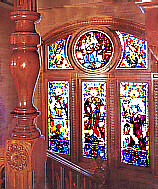 Carved oak frames the fireplace.
The beveled mirrors and glass were imported from England. Although remaining a private person,
one can imagine the eloquence of dining in such majesty.
Mr. Carson appreciated the designs in leaded glass and they appear in several places
throughout the house. Most notable of the stained glass windows are found in this grouping
at the turn of the main stairway. The medieval garbed figures represent the four arts:
painting, music, drama, and science.
Carved oak frames the fireplace.
The beveled mirrors and glass were imported from England. Although remaining a private person,
one can imagine the eloquence of dining in such majesty.
Mr. Carson appreciated the designs in leaded glass and they appear in several places
throughout the house. Most notable of the stained glass windows are found in this grouping
at the turn of the main stairway. The medieval garbed figures represent the four arts:
painting, music, drama, and science.
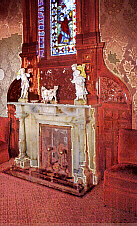 Another example of this glass works can be found in the onyx fireplace in the music room.
The fireplace itself is flanked by redwood paneling and Philippine mahogany
carved with an intricate leaf design. The fireplace has a double flue which divides to
provide space for a leaded stained glass window. There is a third fireplace in the library on the second floor.
All together
there are five fireplaces in the house. It is believed
that he brought at least two wood carvers from Europe for the project. John Rudoff Etteline
came from Switzerland and Patrick Glennon came from Ireland. These men are credited
Another example of this glass works can be found in the onyx fireplace in the music room.
The fireplace itself is flanked by redwood paneling and Philippine mahogany
carved with an intricate leaf design. The fireplace has a double flue which divides to
provide space for a leaded stained glass window. There is a third fireplace in the library on the second floor.
All together
there are five fireplaces in the house. It is believed
that he brought at least two wood carvers from Europe for the project. John Rudoff Etteline
came from Switzerland and Patrick Glennon came from Ireland. These men are credited
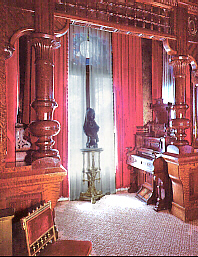 with several other
artistic endeavors
about town.
with several other
artistic endeavors
about town.
Red colors and redwood woodwork dominate the music room. The window alcove is framed in all
three types of the wood's grain, namely burl, curly and clear. The mansion’s outstanding
example of the woodcarvers' art is found in this room, which still display the original chairs,
upholstered in red.
William Carson died quietly, on February 10, 1912, in the castle where he had lived for 24 years.
His sons would continue running the various business that he had created. The house would be
occupied by various family members until, in 1950, it was sold for a token thirty fire thousand
dollars to a local group who created the Ingomar Club.
***THE END***

